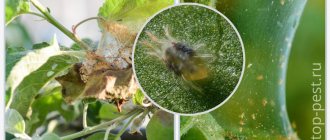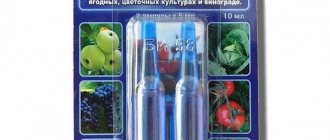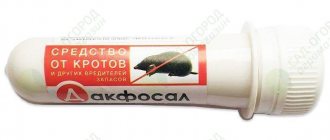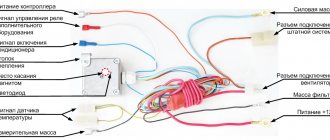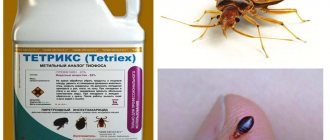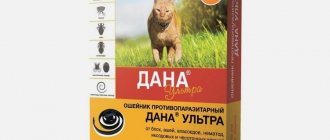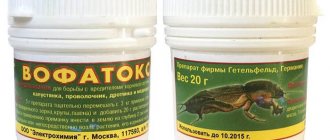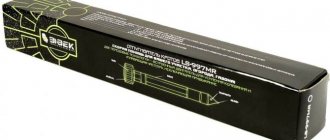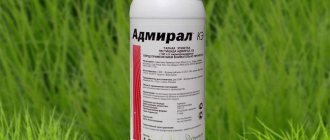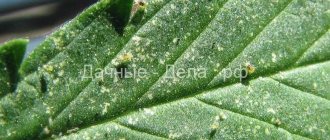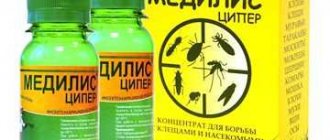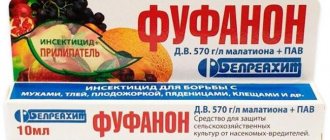Growing a crop of cucumbers is not always easy or simple. Although this culture is grateful, sensitive to care and feeding, it is at the same time vulnerable. And if it is difficult to deal with changeable weather conditions, then protecting the mustachioed vegetable from numerous diseases and pests is quite possible. We tell you how to fight spider mites using the drug Antimite.
Active substance and formulation
"Anti-tick" is a contact-intestinal acaricide that helps to cope with most types of ticks. It is especially effective against the spider variety of parasites. The composition can be used for processing different types of crops - vegetables, berries, fruits. The drug is suitable for use on private farms.
The substance is released in the form of an emulsion concentrate. It is sold in 10 ml containers. The active ingredient is malathion. 1 liter of product contains 525 grams of the substance.
Folk remedies
There are a lot of traditional ways to combat ticks. Below are the most effective and easy to prepare.
- A decoction of black henbane. Take 1 kg of dried and chopped henbane leaves and pour 10 liters of boiling water. Let it sit for 12 hours, strain and add 40 g of liquid laundry soap. Soap is added so that the solution lingers on the leaves and does not roll off immediately.
- A decoction of medicinal dandelion. For 10 liters of hot water, take 500 g of fresh leaves or 300 g of dry roots. The broth should stand for a day, after which it must be strained and you can water the plants.
- Decoction of field chamomile. Take 1 kg of dry chamomile per 10 liters of hot water. Let it brew for 12 hours. After this, strain, dilute with water, add 40 g of soap and you can begin processing.
- Garlic solution. Take 30 g of garlic per bucket of water. The solution is infused for about a day in a dark place. You can add laundry soap.
- Onion infusion is also effective in the fight against ticks. Take 200 g of fresh husk and fill it with warm water. The decoction is left for 12 hours, then filtered and applied as directed on the affected plants.
- Hot peppers. Take 50 g of red hot pepper per 500 ml of water. Spray the leaves.
- Hydrogen peroxide 3% is used in a proportion of 20 ml per 1 liter of settled water. Hydrogen peroxide works best against mites. Safe for humans, there is no odor and the effect appears immediately.
- You can use a vinegar-based solution. Vinegar is harmful to ticks.
Resistant varieties of cucumbers:
It is difficult to find cucumber varieties that are resistant to spider mites, but there are hybrids that are characterized by increased immunity and resistance to most diseases: Stork, Aquarius, Unity, Lotus, Phoenix, Khabar, Electron, Golubchik, Debut, Zhuravlenok, Katyusha, Idol, Nightingale.
Spectrum and mechanism of action of the drug "Antiklesch"
The substance is characterized by a unique ovicidal effect. To cope with eggs and larvae of spider mites, literally one spray will be enough. At the same time, the drug has a gentle effect on the natural enemies of parasites. The product is devoid of phytotoxic properties.
Expert opinion
Zarechny Maxim Valerievich
Agronomist with 12 years of experience. Our best country expert.
Ask a Question
With a single timely spraying of plantings, the product helps protect them from ticks for 2-3 months. It is important to carry out the treatment before the larvae revive.
The drug helps to cope with different types of ticks. It can be used for processing berry plants, fruit crops, vineyards or hops.
Prevention of spider mites on cucumbers
Crop rotation is a key requirement for spider mite prevention. Since cucumbers are the pest’s favorite food, they cannot be planted twice in the same place. Tomatoes and eggplants are rarely affected by the parasite due to the presence of numerous hairs on the leaves.
Remove weeds around the borage in a timely manner. This reduces the chance of infection. Since the spider mite initially appears there, and only then moves to vegetables.
Plant beds with cucumbers with crops that repel spider mites. Such properties are characteristic of calendula, basil, onion, garlic and parsley.
Constantly monitor the crop in order to notice the pest in time and take the necessary control measures.
Advantages and disadvantages
Advantages and disadvantages
high efficiency;
wide spectrum of protective action;
versatility of use;
quick effect - observed half an hour after exposure;
lack of phytotoxic properties for plants and low toxicity for warm-blooded animals;
long-term protective effect - it lasts for 25 days;
effectiveness at all stages of parasite life;
compatibility with various crop protection products.
The drug has virtually no disadvantages. The main disadvantage is the need to strictly follow the instructions and use personal protective equipment.
See also
Instructions for use of Bromadiolone, effect on humans and dosageRead
Description
Spider mites are a very common pest found on vegetable crops including cucumbers, eggplants, peppers and tomatoes. It belongs to the class of arachnids, so it is difficult to call it an insect and will withstand treatment against simple midges. Small and almost invisible at first glance, spider mites are capable of completely destroying a plant. Its appearance is characteristic: the color can be red, yellow or orange.
The body of a spider mite is small and has a round shape. There are small bristles on the body that hold an air bubble around the tick during rain. This creates additional difficulty when destroying with water. The pest lives on the back of the leaves, so it is difficult to notice. During its life, it feeds on plant sap, so after some time you can see whitish spots on the outside of the leaf.
Temperatures above 15 degrees are favorable for the development of larvae and active reproduction. At this temperature, the larva develops within 2 weeks. But if the weather is dry, hot, with a temperature of +30 degrees, then the embryo from an egg into an adult can develop in 2-3 days. With the onset of cold weather, the spider mite ceases to lead an active lifestyle and goes down to find a place to hibernate. In greenhouses, this is the top layer of soil, the place under leaves and dried plants.
There are many types of spider mites, but the most common are the following:
- Red common spider mite;
- Red-legged spider mite;
- Spider mite Savzdarga;
- Atlantic spider mite.
Instructions for use
To ensure that the drug does not cause harm to health and has a good effect, it is important to strictly adhere to the recommendations specified in the instructions. The composition belongs to the category of water-soluble emulsions. The instructions say that 10 milligrams of the substance must be mixed with 10 liters of water.
To mix the working solution, do the following:
- pour 2 liters of clean water into a bucket;
- open the package, enter the required volume of emulsion;
- mix everything well;
- add the solution to the required volume and mix again;
- pour into a sprayer;
- The solution remaining after use cannot be stored.
Crops must be processed early in the morning or in the evening. It is important to ensure that the wind speed is no more than 2 meters per second.
What are pests and why is their invasion dangerous for cucumbers?
The herbivorous pest from the mite family can be found everywhere. In total, more than 1 thousand species of arachnid parasites have been discovered in nature, differing in their life cycles and feeding habits. The most famous representative is the common spider mite, which does not survive only in Antarctica.
The size of animals does not exceed 1 mm. The color of the body can be yellow-green or brownish. Females leaving for the winter are more brightly colored: they are red.
Over the course of a season, several generations of parasites are born. During her life, one female is capable of laying several hundred eggs, from which larvae hatch within 3 days. After two moults they turn into adults. Adult pests live for about a month.
Eggs laid by females on plant roots, in the ground, on foliage or under plant debris do not die even under unfavorable conditions. The development of the embryo stops for a while. Larvae may appear even after several years.
When daylight hours become less than 15 hours and the temperature drops below +18 degrees, ticks enter diapause, during which they do not move or feed, expending accumulated energy reserves. At this stage, the pest becomes resistant to climatic factors and the action of most chemical compounds.
In early spring, when the thermometer reaches +12...+15 degrees, animals come out of their hiding places. Females begin oviposition by weaving a web around the lower surfaces of leaves of seedlings or weeds and leaving future offspring in it.
It is on greenhouse cucumbers or on plants grown in greenhouses that the mite often settles, since the conditions created in the shelters are ideal for its life, and it really likes the fleshy green mass of the crop.
For nutrition, the tick uses sap from plant cells. Weakened cucumbers begin to wither and quickly die. Their immunity is reduced, as a result of which the crop is easily affected by fungal and bacterial infections: powdery mildew, various types of rot, mosaic virus, etc.
It is very difficult to detect ticks before they reproduce. This can only be helped by a daily inspection of the lower parts of the leaves, which, upon careful examination, can reveal dangerous parasites.
The spider mite is not an insect, but an animal, so many drugs developed for plant protection do not work on it.
Having discovered a spider mite on cucumbers in a greenhouse, you must immediately take measures to save the crop.
Safety precautions when working with Antiklesch
The product belongs to the third hazard class. This means that it is considered a moderately hazardous substance. To avoid problems when processing cultivated plants, you should carefully observe all precautions during the preparation of the emulsion. This is done during and after direct spraying.
The drug must be kept only in its original packaging. It should be in a cool place with adequate ventilation. It is important to keep it separate from medicines, seeds, food products, and fodder. The product must be kept out of the reach of children and animals.
When processing cultivated plants, it is recommended to use personal respiratory protection, gloves, and work clothes.
Preventive measures
The appearance and reproduction of spider mites is facilitated by low humidity and hot weather. Regular spraying of plants with a spray bottle can be an excellent prevention of the pest. However, there is a danger here - if it is a false spider mite, then there will be even more of it, because it loves high humidity. It is not possible to wash off the spider by immersing it in water, since it protects itself with an air bubble. In a greenhouse, the occurrence of a mite is unlikely, because constant humidity is maintained there, but if thermoregulation is still impaired, the mite will begin its parasitic activity.
First aid
At the first symptoms of poisoning, you should stop working, remove the victim from the area of exposure to the substance, and carefully remove dirty clothing and protective equipment. In this case, it is necessary to avoid possible contact of the substance with the skin or respiratory organs. There must be a flow of fresh air into the room. Then you definitely need to call a doctor.
First aid for poisoning with a substance depends on the area of exposure:
- If the composition penetrates the respiratory organs, the person must be taken to fresh air.
- If the composition gets on the skin, remove it with a piece of soft paper, cloth, or cotton wool. At the same time, you should not rub the skin roughly. After which you need to wash the contaminated area with soapy water.
- In case of contact with eyes, rinse immediately with clean running water.
- In case of accidental ingestion, rinse the mouth with water and give the victim several glasses of activated carbon solution. It is recommended to use 1 gram of the drug per 1 kilogram of weight. Then, by irritating the posterior pharynx, provoke vomiting and carry out this procedure several times. Then you need to take another 1 glass of activated carbon solution and immediately consult a doctor.
See also
Instructions for use and composition of the Lamador disinfectant, dosage and analoguesRead
In case of poisoning with Anti-Tick, it is necessary to use specific antidotes. The most effective agents include toxogonine and atropine sulfate.
Prevention of pest occurrence
In addition to means of combating spider mites, comprehensive prevention is also important.
It can be divided into 3 stages:
- in the spring - preparation;
- all season - current;
- before wintering - final.
In the spring, you need to clean the room after wintering and sterilize the soil. For this:
- wash the greenhouse structure with soapy water, after adding chlorine to it;
- dig up the soil to 25-30 cm;
- treat it with boiling water;
- cover the soil tightly with film for 3 days;
- fumigate the room with sulfur bombs;
- spill the soil with a one percent manganese solution.
During ongoing prophylaxis:
- high humidity must be maintained in the greenhouse;
- plant plants at a distance of one and a half meters;
- regularly inspect planted vegetables;
- remove parts of leaves on bushes;
- mulch the soil;
- spray the soil and plants with onion infusion.
Autumn:
- completely remove plant debris and various auxiliary structures;
- Dig the soil carefully, adding lime or phosphate fertilizers.
ACTUAL NEWS
You may also find the following materials useful:
- Pharmacy activated carbon: top 8 options for use in the country
- Why does the earth crack after watering, and what to do in this situation
- The best remedies for late blight on tomatoes: the most effective, how to treat
- What can be made from tomato tops: use herbal infusions
- When and what to feed garden cabbage: the best options for organic fertilizers
Methods for controlling spider mites
The ability of the pest to actively reproduce creates a big problem for gardeners. Under favorable weather conditions, more than 10 generations of an animal can appear in a season. The web with which parasites envelop plants has the ability to repel moisture, which also complicates treatment with anti-mite medications. However, today a number of means have been developed that are highly effective even in the fight against this dangerous creature.
What difficulties may gardeners encounter:
- microscopic nature of the pest, which makes it difficult to detect in time;
- the ability of the tick to reproduce at high speed;
- the presence of a web that protects animals from chemicals;
- the appearance of resistance to the drug in the tick over time;
- inability to carry out frequent treatments of plantings.
Store-bought drugs
Chemicals should be used alternately. It is precisely because the tick develops immunity to certain insecticides that it is not so easy to deal with. During processing, you need to make sure that the liquid gets not only on the bush itself, but also on the soil around the plant, where females can lay eggs and larvae hide.
It is important to carefully study the instructions supplied with the drug. Otherwise, you may not only not stop the pest invasion, but also cause additional damage to the plantings.
It is recommended to use acaricides to kill ticks. These are chemical or biological based products specifically designed to reduce the number of arachnids.
Today, manufacturers offer three categories of drugs that kill ticks:
- Insectoacaricides - used to combat both ticks and harmful insects. This group includes compositions based on organophosphorus compounds, pyrethroids and inorganic sulfur.
- Acaricides specially developed against ticks.
- Acarofungicides that effectively destroy both mites and pathogenic microorganisms.
Karbofos
A drug containing an organophosphate component (malathion) has been used in the fight against parasites for a long time. Despite the emergence of more modern means, it is still popular among gardeners due to its ability to destroy many plant pests (both insects and herbivorous mites).
Features of the insecticide:
- Karbofos affects parasites only by contact, that is, only when it comes into contact with them.
- With constant use of the drug, ticks develop immunity.
- The product does not act for long and is quickly destroyed by climatic factors.
- The plants should be wetted completely, since only the treated areas will be protected from the pest.
Karbofos is available in the form of powder, concentrates or ready-to-use composition.
Treatment should be carried out with a freshly prepared solution. The best time for this is morning or evening, when the air temperature does not exceed +15...+18 degrees.
The drug cannot be used during flowering of crops.
The working fluid is prepared from 60 g of powder and a bucket of water. Solution consumption: 10 liters per hundred beds. Treatment is carried out a month before the expected harvest of cucumbers.1
Apollo
Clofentesine is used as the main component of the acaricide. The concentrated suspension is available in 1 and 5 liter bottles. The contact action drug destroys pest larvae and their eggs, but does not pose a danger to adults. Apollo also does not kill insects that may also be on the plant affected by the mite.
Protection lasts about a month. During the growing season, cucumbers require two treatments. The solution can be prepared from a bucket of water and 4 ml of suspension. The waiting period is a month.
Apollo can be used simultaneously with other chemicals, with the exception of those containing sulfur and copper, as well as alkaline preparations.
Important! To ensure the compatibility of insecticides, they should be mixed and observed for the reaction. If it is noticeable, you cannot combine chemistry.
Flumite
The acaricide contains the active ingredient flufenzin, which has a detrimental effect on most types of ticks, killing them at all stages of development. The drug belongs to the 4th class in terms of danger; it has no effect on beneficial insects.
To prepare the solution, you need to dissolve 4 ml of the product in a bucket of water, after which the liquid can be sprayed. Since pests quickly develop an addiction to the drug, it is recommended to treat it only once per season. The procedure can be carried out at different stages of the cucumber growing season: spring, summer and autumn. The protective effect of the drug lasts two months. Flumite can be used together with growth regulators.
Omite
The acaricidal agent is effective against mites that have occupied fruit, ornamental and vegetable crops. The basis of the drug is propargin. It destroys both adult ticks and parasites at the larval and nymph stages. However, it does not affect embryos in eggs. But, since the poison is effective for 20 days, the larvae that emerge from them are also likely to die. Thanks to the use of Omite, you can completely get rid of pests in greenhouse beds within a short time.
Consumption of the drug per 10 liters of water is 30 ml. The product is highly toxic, including to bees, but usually these beneficial insects are practically absent in greenhouses.
Bitoxibacillin
Bacteriological insectoacaricide is available in the form of powder or suspension. Once in the body of ticks, the active substance causes blood poisoning, affects the reproductive system and digestive organs, which leads to the rapid death of parasites.
Using Bitoxibacillin, you can get rid of pest larvae. The biological product has practically no effect on adults.
Processing of greenhouse cucumbers is carried out using a sprayer. The number of procedures during the growing season of plants can reach up to six (depending on the degree of infection of the plantings). Between them you need to take two-week breaks.
To prepare a working solution, 100 g of the product are diluted in a bucket of water. Its temperature should not exceed +20 degrees. To better fix the composition on the foliage, it is recommended to add a small amount of soap (any kind) to it.
The effect of using a protective agent will be noticeable within a day. The maximum activity of Bitoxibacillin is observed 5...7 days after applying the solution to plants.
The pesticide is non-toxic; treatment can be carried out during fruiting, 5 days before harvesting vegetables.
Traditional methods
Self-prepared formulations are not as effective as insecticides. However, many gardeners prefer traditional recipes, since such remedies will not cause harm to people and the environment.
- The beds can be treated with liquids with a pungent odor: solutions of ammonia, vinegar, essential oils or infusions of a number of plants: garlic, onions, horseradish, etc.
- Ticks do not tolerate wet environments. By creating a humidity level above 80% in the greenhouse for several hours, you can get rid of most parasites.
Several options for effective compositions:
Infusions of garlic and celandine
To prepare a protective agent, chop 1/4 kg of garlic and add a bucket of water to the mass. The composition must infuse for 24 hours, after which it is filtered. The next day, an infusion of celandine greens is prepared. To do this, 1 kg of plant is filled with boiling water (3 l) and the container is left for a day. The mass is filtered, water is added to it so that the volume of liquid is 10 liters. To get rid of the mite, combined treatments are carried out: one day, the cucumber bushes are sprayed with garlic, the next day, a celandine-based product is used. After 6 days (you need to do 3 sprays with each infusion), there should be no traces of ticks left.
Green soap
This thick liquid can be used both to kill spider mites and for prevention. The product contains potassium salts of fatty acids (base), vegetable oil, animal fat and water. The spray liquid is prepared from 200 g of the drug and a bucket of water. On foliage treated with green soap, an environment is created that prevents the vital activity of parasites. Deprived of the opportunity to eat and reproduce, pests die after some time. To protect cucumbers, carry out 3 sprayings with an interval of 7 days.
Alcohol treatment
You can wipe the foliage of plants with undiluted medical alcohol by soaking a sponge in the liquid. Alcohol has a detrimental effect on adult ticks, but it does not kill the embryos in the eggs. Therefore, this method is recommended to be used in combination with other methods.
Alcohol evaporates quickly, so it does not harm the crop, but young foliage should not be wiped with alcohol.
In addition to the options listed, you can use others: wipe the leaves with a solution of rosemary oil or laundry soap, spray the bushes with an infusion of onion peels or hot peppers, and also dust the plants with tobacco dust.
IMMUNIZATION/VACCINATION
a) for a person
The vaccine is the most effective way to protect against tick-borne encephalitis.
Vaccines currently used in humans are:
- Klesh-E-Vac or EnceVir , manufactured in the Russian Federation based on Far Eastern strains.
- FSME-Immun/Junior , manufactured in Austria and Germany, respectively, based on European strains of the virus;
Russian and imported vaccines are similar in structure and therefore are interchangeable; they can be changed during one vaccination: for example, administer the first dose with a Russian drug, and the second and third with an imported one.
Vaccination against tick-borne encephalitis takes place in several stages. There are several vaccination schedules that differ slightly in the timing of administration.
Approximate VACCINATION SCHEME for humans:
- 1 vaccination
- 2nd vaccination - after 1-3 months
- 3rd vaccination - after 12 months.
- After three years - revaccination, repeated every three years.
Vaccination against tick-borne encephalitis.
Examples of vaccines Immune protection against tick-borne encephalitis appears approximately two weeks after the second dose of the vaccine, regardless of which drug was administered. Failure to schedule vaccination may prevent the development of a full immune response.
The first dose is best administered in March. It is important to understand that the likelihood of being bitten by a tick is the same for a vaccinated and unvaccinated person. Immune protection is formed in more than 87% of those vaccinated against tick-borne encephalitis. Even if infection occurs, the disease will be much milder than in unvaccinated people, and, as a rule, without complications.
The vaccination procedure is carried out strictly according to indications and with a referral (authorization) from a doctor. Vaccination is contraindicated for any acute diseases, as well as chronic diseases in the acute stage, severe allergies, especially to egg whites, severe reactions to the previous dose of the vaccine (for example, fever above 40°C) and pregnancy
Unfortunately, in Russia more than 5-7% of Russians are vaccinated annually. In Austria, for example, more than 90% of Austrians have been vaccinated against the virus.
b) for pets (dogs, etc.)
Vaccination of a dog - prevention of tick bites
As for domestic animals, the following VACCINES are used for vaccination:
- " Nobivac Piro"
- " Eurican Piro " (Eurican Piro);
- " Pirodog " (Pirodog), etc.
Tick bite prevention for pets includes the use of TICK TABLETS FOR DOG. The tablets are classified as insecticides; they differ fundamentally from each other in composition and the active substance used (fluralaner, afoxolaner, spinosad, milbemycin, sarolaner, etc.)
Among the most used today:
- «Bravecto»
- «Frontline NexgarD»
- «Nexgard Spectra»
- «Simparinka»
- " Comfortis " and others.
| READ MORE: “Tick tablets for dogs – TOP 5 best (comparative analysis)” |
Risk factors for tick bites
Ixodid (encephalitis) ticks are the source of the most dangerous encephalitis viral infection, posing a serious danger to the health of humans and their pets. Delayed assistance can lead to death.
The main danger of ticks is the transmission of tick-borne encephalitis . Tick-borne encephalitis is a viral inflammation of the central and peripheral nervous system, leading to memory and intelligence disorders, and severe complications can result in paralysis and even death. In addition, they are carriers of relapsing tick-borne typhus , tick-borne typhus, tularemia, hemorrhagic fever, ehrlichiosis and other diseases.
Every year, up to half a million citizens of our country seek medical help for tick bites!!!!!, about 30% of them are children.
For dogs or other animals, the consequences of a tick bite are also catastrophic. So in dogs, in a latent form without treatment, tick-borne encephalitis leads to 95% mortality.
A dog tick bite can lead to dangerous viral diseases:
- piroplasmosis (destruction of hemoglobin cells with damage to all internal organs);
- encephalitis (nervous disorders leading to blindness, paralysis of the limbs);
- borreliosis or Lyme disease (inflammation of the joints, leading subsequently to chronic painful arthritis);
- bartonellosis (disorders of the nervous system, the dog loses orientation in space and cannot walk correctly);
- hepatozoonosis (purulent discharge from the eyes, muscle pain and severe fever).
How to protect yourself and your pets from tick bites? How to protect yourself from such serious consequences? How to provide emergency assistance? What does tick bite prevention include?
VISUAL INSPECTION
After being in the forest, as well as after any walks in nature, thorough self- or mutual examinations are carried out to identify ticks. It is mandatory to inspect your pet after walks. It would be a good idea to regularly check yourself and your pet during the walk. If you remove a tick in time, the likelihood of infection is significantly reduced.
| READ MORE: “How to safely remove a tick? (SIX proven methods)" |
PROTECTIVE CLOTHING
a) for a person
For a short stay in nature, it is advisable to dress in light-colored clothing made from thick fabrics. Fasten the collar and cuffs, tuck the trousers into shoes/socks - minimize exposed areas of the body. A headdress is required - a cap/kerchief. For tourists, hunters, forestry workers, special protective suits “Taiga”, “Tourist” or others are used.
Special protective suits - reliable protection against tick bites
The BioStop brand produces suits combining the mechanical and chemical principles of protection. Special flounces located on the suit act as traps for ticks crawling upward. Inside the shuttlecock there is an insert impregnated with an acaricidal substance that is lethal to ticks. Under its influence, the tick dies within a few minutes and falls off the clothing.
b) for pets
For pets, protective anti-tick collars (chemical, biological or ultrasonic) are used.
The most commonly used are collars based on the chemical principle of action (with an insectoacaricidal drug applied):
- " Foresto " (Bayer, Germany);
- " Kiltix " (Bayer, Germany);
- " Scalibor " (France);
- " Beaphar " (Netherlands);
- " Bars " (Russia).
| READ MORE: “Tick collar for dogs – how to choose? TOP 5 best" |
